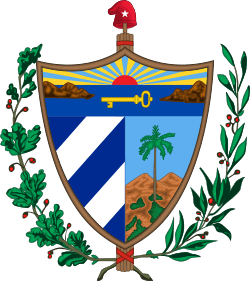Cuban exile
The term Cuban exile refers to exodus of Cubans from the island of Cuba after the Cuban Revolution of 1959. Many would flee to the United States, but others would find refuge in other countries. The first wave of emigration occurred directly after the revolution, followed by the Freedom Flights from 1965 to 1973. This was followed by the 1980 Mariel boatlift and after 1994 the flight of balseros emigrating by raft. During the Cuban exile many refugees were granted special legal status by the US government, but these privileges began to be slowly removed as more working class Cubans began to immigrate.[1]
| Part of Aftermath of the Cuban Revolution | |
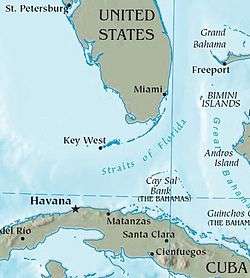 Cuba is 90 miles (145 kilometres) south of Florida in the United States; the destination many exiles head towards. | |
| Date | 1959 – present |
|---|---|
| Location | |
| Cause |
|
| Outcome | Waves of emigration
|
Part of a series on the |
|---|
| History of Cuba |
 |
| Governorate of Cuba (1511–1519) |
| Viceroyalty of New Spain (1535–1821) |
| Captaincy General of Cuba (1607–1898) |
| US Military Government (1898–1902) |
| Republic of Cuba (1902–1959) |
|
| Republic of Cuba (1959–) |
| Timeline |
|
|
| Topical |
|
|
History
The majority of the 1,172,899 current Cuban exiles living in the United States live in Florida (917,033 in 2014), mainly in Miami-Dade County, where more than a third of the population is Cuban. Other exiles have relocated to form substantial Cuban communities in New York City (16,416), Louisville, KY (6,662), Houston, TX (6,233), Los Angeles (6,056), Union City, NJ (4,970) and others.[2]
Golden exile and Bay of Pigs Invasion
Before the post-revolution exile around 50,000 Cuban Americans already resided in the United States. Immediately after the 1959 Cuban Revolution around 200,000 Cubans came to South Florida. Of these emigrants many were collaborators in the recently toppled Batista regime, of the middle or upper class, and of European descent. Many emigrants believed their exile was temporary since Fidel Castro would soon be toppled. Travel between the United States and Cuba was not heavily restricted even in the wake of the recent revolution. In 1960 Dwight D. Eisenhower established the Cuban Refugee Emergency Center which offered public services to Cuban emigrants. Many immigration restrictions were specifically waived for Cubans entering the United States.[1]
Many of these original Cuban exiles were involved in the 1961 Bay of Pigs Invasion which failed to topple Fidel Castro. After the Cuban Missile Crisis of 1962 the Cuban government would restrict air traffic to the island, ending the first major wave of emigration.[1]
Operation Peter Pans
To destabilize the communist dictatorship, the CIA and Cubans dissidents began warning of a project by the Castroist government, to remove the parents' custody of their children to indoctrinate them. Between November 1960 and October 1962, over 14,000 children were sent to the U.S. by their parents in Operation Peter Pan. These children were taken under the care of the Catholic Church and placed in foster homes throughout the U.S until they could be reunited with their parents. Their parents sent them into the U.S in order to keep them from communist indoctrination, with many boys being sent to avoid getting drafted into the Cuban armed forces, and girls being put into the greatly politized Alphabetization Campaign.[3]
Camarioca boatlift
On 28 September 1965, Fidel Castro announced that Cubans wishing to emigrate could do so beginning 10 October from the Cuban port of Camarioca. The administration of U.S. President Johnson tried to control the numbers it would admit to the U.S. and set some parameters for their qualifications, preferring those claiming political persecution and those with family members in the U.S. In negotiations with the Cuban government it set a target of 3,000 to 4,000 people to be transported by air. Despite those diplomatic discussions, Cuban Americans brought small leisure boats from the United States to Camarioca. In the resulting Camarioca boatlift, about 160 boats transported about 5,000 refugees to Key West for immigration processing by U.S. officials. The Johnson administration made only modest efforts to enforce restrictions on this boat traffic. Castro closed the port with little notice on 15 November, stranding thousands. On 6 November, the Cuban and U.S. governments agreed on the details on an emigration airlift based on family reunification and without reference to those the U.S. characterized as political prisoners and whom the Cubans termed counter-revolutionaries. To deal with the crowds at Camarioca, the U.S. added a maritime component to the airborne evacuation. Both forms of transport started operating on 1 December.[4][5]
Freedom Flights
From December 1965 to early 1973, under the Johnson and Nixon administrations, twice daily "Freedom Flights" (Vuelos de la Libertad) transported émigrés from Varadero Beach to Miami. The longest airlift of political refugees, it transported 265,297 Cubans to the United States with the help of religious and volunteer agencies. Flights were limited to immediate relatives and Cubans already in the United States with a waiting period anywhere from one to two years.[6]
Many who came through Camarioca and the Freedom Flights were much more racially diverse, of lower economic standing, and of more women compared to earlier emigration waves. This is mainly due to Castro's restriction not allowing skilled laborers to leave the country.[1]
Rapprochement with Cuba
During the Carter administration various actions were taken to better relations between the United States and Cuba. In 1978 the first commercial flight in sixten years would fly from Miami to Havana. The Cuban government would also allow the visit the Antonio Maceo Brigade, the first visit of Cuban exiles to the island. Many Cuban exile organizations would protest the warming of relations with Cuba while some other organizations supported increased diplomacy.[7]
Mariel boatlift
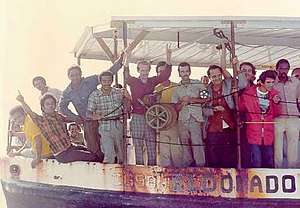
Between 26 April and 1 October 1980, during the Carter administration, probably one of the most significant waves of exiles occurred during what became known as the Mariel Boatlift. The mass boatlift occurred after a number of Cubans drove a bus through the gates of the Havana Peruvian Embassy and requested asylum. One embassy guard died as a result of friendly fire when another guard machine gunned the incoming bus and hit the first one accidentally. When the Peruvian ambassador refused to return the exiled citizens to the authorities, Castro removed the Cuban guards from the embassy, basically opening the door to the 4,000 plus asylum seekers that came into the embassy within the next few days. Reacting to this sudden exodus, Castro stated, "Anyone who wants to leave Cuba can do so" and declared that those who were leaving the country were the "escoria" (scum).
This resulted in an even larger exodus through the port of Mariel, where an improvised flotilla of Cuban exiles from Miami in small pleasure boats and commercial shrimping vessels brought Cuban citizens who wished to leave the island. Within weeks, 125,000 Cubans reached the United States despite Coast Guard attempts to prevent boats from leaving U.S. waters for Cuba. As the exodus became international news and an embarrassment for the Cuban government, Castro emptied his hospitals and had prison inmates rounded up as "social undesirables",[8][9] and included them among the other refugees. The Cuban Communist Party staged meetings at the homes of those known to be leaving the country. People were intimidated by these "repudiation meetings" (mitines de repudio), where the participants screamed obscenities and defiled the facades of the homes, throwing eggs and garbage, for hours. Labeled as "traitors to the revolution" those who declared their wish to leave became the targeted victims of the attacks, their rationing cards were taken from them, their jobs were terminated, or they were expelled from schools or universities. Towards the end of the crisis, the repudiation meetings were ended. The scale of the exodus created political difficulties for the Cuban government, and an agreement was reached to end the boatlift after several months. Out of more than 125,000 refugees, a number from as low as 7,500 to as high as 40,000 were believed to have criminal records in Cuba, though many of their crimes would not qualify as crimes under U.S. law. Some 1,774 of the refugees were classified as serious or violent criminals under U.S. law and denied citizenship on that basis. The majority of refugees were young adult males, 20 to 34 years of age, from the working class: skilled craftsmen, semi-skilled tradesmen, and unskilled laborers.
In response the aftermath of the Mariel Boatlift, the City of Miami formed the East Little Havana Task Force in 1983. [10] Task Force members were appointed by the Miami City Commission [11] and it was chaired by urban planner and Cuban community leader Jesus Permuy.[12] It was tasked with studying the social and economic effects of the boatlift, particularly in Little Havana, which was an epicenter of the migration. The Task Force adjourned a year later and submitted its findings and official recommendations, called The East Little Havana Redevelopment Plan, to the Miami City Commission and Mayor's Office in 1984.[13] Also in 1984, the United States and Cuba negotiated an agreement to resume normal immigration and to return to Cuba those persons who had arrived during the boatlift who were "excludable" under U.S. law.
Balseros
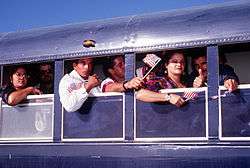
During the past years, exile waves have consisted of balseros, who travel in homemade rafts. On 18 August 1994, U.S. Attorney General Janet Reno said in a press release:[14]
To divert the Cuban people from seeking democratic change, the government of Cuba has resorted to an unconscionable tactic of letting people risk their lives by leaving in flimsy vessels through the treacherous waters of the Florida Straits. Many people have lost their lives in such crossings. We urge the people of Cuba to remain home and not to fall for this callous maneuver. I want to work with all concerned including the Cuban American community to make sure the message goes out to Cubans that putting a boat or raft to sea means putting life and limb at risk... To prevent this from happening again, the Coast Guard has mounted an aggressive public information campaign so people know that vessels... may be stopped and boarded and may be seized. Individuals who violate U.S. law will be prosecuted in appropriate circumstances.
President Clinton, trying to stem the flow of Cuban rafters, pressed a dozen Latin American governments to provide internment camps that officials hoped would prove more attractive to refugees than the U.S. Navy base at Guantanamo Bay in Cuba. Although the refugees at Guantanamo were held behind barbed wire, to many, the base was less forbidding than a foreign internment camp.
As a result of bilateral migration accords between the two governments, in September 1994 and May 1995, the status quo of U.S. policy toward Cuban migrants was altered significantly. The U.S. granted Cuba an annual minimum of 20,000 legal immigrant visas and, at the same time, determined that Cubans picked up at sea would be sent home just as any other group of illegal immigrants. President Clinton's agreement with Cuba resolved the dilemma of the approximately 33,000 Cubans then at Guantanamo. This new agreement had two new points. The United States agreed to take most of the Cubans detained at Guantanamo through the humanitarian parole provision. Cuba agreed to credit some of these admissions toward the minimum quota of 20,000 migrants from Cuba, with 5,000 charged annually over the years. Secondly, rather than placing Cubans intercepted at sea in a camp, the United States began sending them back to Cuba. Both governments promised to follow international agreements to ensure that no action would be taken against the people returned to Cuba.
As a result of these migration agreements and interdiction policy, a "wet foot/dry foot" practice toward Cuban immigrants has developed. Those who do not reach dry land are returned to Cuba unless they fear persecution there, but only those who meet the definition of asylum refugee are accepted for eventual resettlement in a third country. Those Cuban rafters who do reach land are inspected by Department of Homeland Security and usually are allowed to stay in the United States. From May 1995 through July 2003, about 170 Cuban refugees were resettled in eleven different countries, including Spain, Venezuela, Australia, and Nicaragua. Since March 2003 the State Department has not been allowed to monitor the treatment of the immigrants returned to Cuba. The wet foot/dry foot was abruptly ended by President Obama days before he ended his second term in 2017,[15] which sparked controversy for the Cuban Exile community [16]
Cuban Thaw and aftermath
President Barack Obama announced he would restore diplomatic relations with Cuba in 2014. After negotiations with the Cuban government, the Obama administration agreed to end the Wet feet, dry feet policy and Cuba agreed to give reparations to Cuban nationals. Later President Donald Trump would prioritize deporting any immigrant who entered the U.S. illegally including Cubans. It became almost impossible for Cubans to legally apply for visas to the U.S. after the U.S. embassy in Havana was closed after sonic attacks against the facility.[17]
Cuba - United States relations
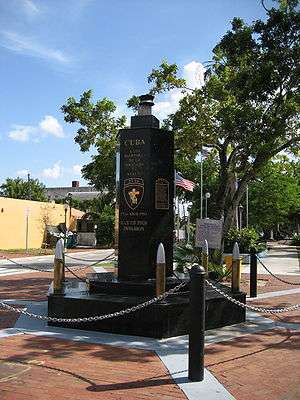
Political activity
Acts have occurred in U.S. regions and at least sixteen other countries,[18] carried out by groups such as Alpha 66,[19][20] Omega 7,[21] and the Coordination of United Revolutionary Organizations.[22] A series of bombings in Miami in the mid-1970s led to hearings before a U.S. Subcommittee to investigate internal security.[23] Notable cases of violence targeting individuals include that of Luciano Nieves, who was murdered after advocating peaceful coexistence with Cuba, and WQBA-AM news director Emilio Milian who survived a car bomb but lost his legs after he publicly condemned Cuban exile violence.[18] In 1992 Human Rights Watch released a report stating that hard-line Miami exiles have created an environment in which "moderation can be a dangerous position."[18]
In November 2006, U.S. Congressional auditors accused the development agency USAID of failing properly to administer its program to promote democracy in Cuba. They said that USAID had channeled tens of millions of dollars through exile groups in Miami, which were sometimes wasteful or kept questionable accounts. The report said the organizations had sent items such as chocolate and cashmere jerseys to Cuba. Their report concluded that 30% of the exile groups who received USAID grants showed questionable expenditures.[24]
List of groups
- Brothers to the Rescue - A group of Cuban-American activists that aid Cuban refugees and immigrants. It has tried to distribute opposition literature in Cuba via airdrops.
- US-Cuba Democracy Pac - A group that lobbies the U.S. federal government, "promoting an unconditional transition in Cuba to democracy, the rule of law, and the free market".
- Cuban Liberty Council - Lobbying group for Cuban-Americans in the United States.
- Cuban American National Foundation - Lobbying group for Cuban-Americans in the United States.
- Grupo De Apoyo a la Democracia
- International Committee for Democracy in Cuba Group headed by former Czech president Václav Havel aimed to coordinate the approach of European and western hemisphere countries towards the Cuban government.
- Cuban Libertarian Movement - a loose network of anti-Castro collectives and individuals that make up the Cuban anarchist movement
- Vigilia Mambisa - A group of Cuban-Americans headed by Miguel Saavedra and known for their street-theater tactics and their rapid response to calls for protest aired on Miami Spanish-language radio stations.[25]
Analysis
Various historical analysts and social critics have made analyses of the events of the Cuban exile.
"Golden exiles" myth
Social researcher Jorge Duany has argued that the myth of the "Golden exiles" or the idea that most Cuban exiles are wealthy, well educated, and highly skilled unlike other immigrant populations, is incorrect. He states that many Cuban exiles face cultural and economic challenges resettling in the United States similar to many other American immigrant communities. He also states that as the Cuban exile progressed since 1959 more and more economically disenfranchised Cubans became part of the emigrant waves. These lower class Cuban exiles became noticeable in the Freedom Flights and especially so in the Mariel boatlift and balseros afterwards.[26]
Maria Torres wrote in the Chicago Tribune that contrary to the Golden exile myth Cubans are not entirely racially white but from various racial backgrounds and at the time the article was written in 1986, Cuban American families statistically earned less money than the average white family.[27]
Political motives
According to authors John Scanlan and Gilburt Loescher, United States acceptance of Cuban emigrants after the 1959 Cuban Revolution was done in hopes they could help the United States forcibly remove the Fidel Castro government from Cuba. The acceptance of Cuban emigrants during the Freedom Flights was done in hopes of weakening the Cuban economy by draining it of workers. The United States also was generally able to paint a negative picture of Cuba by participating in the mass emigration of many who disliked Cuba and wished to flee the island. The Department of State painted Cuban emigrants in the 1960s as freedom seeking refugees. By the Mariel boatlift the United States had lost its total aggressive foreign policy towards Cuba and instead viewed the island as a nuisance rather than a security threat. The Mariel boatlift was soon canceled after it was initiated and received little public American support. Fidel Castro benefited from the exile because he was able to remove disloyalty by directly removing disloyal citizens from Cuba.[28]
Social analyst Kelly M. Greenhill argues that the 1994 Cuban rafter crisis was in part engineered by the Cuban government to push social problems out of Cuba and threaten the creation of a humanitarian crisis for the United States. This threat would stimulate fears of Cuban immigrants in the United States as was seen previously during the Mariel boatlift and would be able to change United States policy towards Cuba in Cuba's favor.[29]
See also
- Cuba-United States relations
- Cuban-American lobby
- Opposition to Fidel Castro
- Vietnamese boat people
- North Korean defectors
- Venezuelan refugee crisis
Notes
- Powell, John (2005). "Cuban immigration". Encyclopedia of North American Immigration. Facts on File. pp. 68–71. ISBN 9781438110127. Retrieved 30 November 2016.
- "Ancestry". statistical atlas. Retrieved 2016-03-22.
- "Un ancien espion de la CIA à Cuba raconte sa vie "d'échecs" - Outre-mer la 1ère". francetvinfo.fr.
- Engstrom, David Wells (1997). Presidential Decision Making Adrift: The Carter Administration and the Mariel Boatlift. Lanham, Maryland: Rowman & Littlefield. pp. 24ff. ISBN 9780847684144. Retrieved 24 March 2016.
- "Cuban Americans", by Thomas D. Boswell, in Ethnicity in Contemporary America: A Geographical Appraisal, Jesse O. McKee, ed. (Rowman & Littlefield, 2000) pp144-145
- "Search the Freedom Flights database - The Cuban Revolution". MiamiHerald.com. 30 July 2013. Retrieved 18 April 2014.
- María Cristina García. Havana USA: Cuban Exiles and Cuban Americans in South Florida, 1959-1994. University of California Press.
- "American Experience | Fidel Castro | People & Events". PBS. Retrieved 18 April 2014.
- Cockburn, Patrick (28 August 1994). "Criminals 'in exodus from Cuba': US fears Castro emptying his jails - into Florida". The Independent. Retrieved 18 April 2014.
- "Miami City Commission Picks East Little Havana Task Force". The Miami Herald. March 20, 1983. p. 7B. Retrieved October 8, 2018.
- "E. Little Havana Task Force Meets, Elects Officers". The Miami Herald. May 19, 1983. p. 3. Retrieved October 8, 2018.
- "Study Examines East Little Havana Redevelopment". The Miami Herald. September 27, 1984. Retrieved October 8, 2018.
- "Study Examines East Little Havana Redevelopment". The Miami Herald. September 27, 1984. Retrieved October 8, 2018.
- "Attorney General's Statement on Cuban Influx". United States Department of Justice. Retrieved 17 March 2017.
- Gomez, Alan (12 January 2017). "Obama ends 'wet foot, dry foot' policy for Cubans". usatoday.com.
- NPR, "Cuban-Americans React To Obama Ending Longstanding 'Wet Foot, Dry Foot' Policy"
- NPR, Cuban Immigrants Were Given A Haven In The U.S.; Now They're Being Deported
- The Burden of a Violent History Archived 2009-08-14 at the Wayback Machine Miami New Times. Apr 20, 2000.
- "Cuba Jails 3 Men as Suspects in Sabotage Plot". The New York Times. AP. June 22, 2001. Retrieved August 13, 2015.
- "Andres Nazario Sargen, 88; a Leader of Alpha 66, an Anti-Castro Group". Los Angeles Times. October 9, 2004. Retrieved August 13, 2015.
- Treaster, Joseph B. (1983-07-23). "SUSPECTED HEAD OF OMEGA 7 TERRORIST GROUP SEIZED". Miami (Fla); Cuba; New Jersey; Washington (Dc): NYTimes.com. Retrieved 2016-07-09.
- Kornbluh, Peter. "The Posada File: Part II". The National Security Archive. George Washington University. Retrieved 3 December 2014.
- Terroristic Activity Archived 2007-05-16 at the Wayback Machine : Terrorism in the Miami Area Miami Public pages.
- "Cuba aid money 'wasted' by exiles". BBC News. 16 November 2006. Retrieved 18 November 2006.
- "Have Bullhorn, Will Travel". Miami New Times. 7 December 2000.
- Jorge Duany (1999). "Cuban communities in the United States: migration waves, settlement patterns and socioeconomic diversity". journals.openedition.org.
- Maria Torres (1986). "CUBAN EXILES ARE NOT A BIT GOLDEN". chicagotribune.com.
- Scanlan, John; Loescher, John (1983). "U. S. Foreign Policy, 1959-80: Impact on Refugee Flow from Cuba". The Annals of the American Academy of Political and Social Science. Sage Publications. 467: 116–137. doi:10.1177/0002716283467001009. JSTOR 1044932.
- Greenhill, Kelly (2002). "Engineered Migration and the Use of Refugees as Political Weapons: A Case Study of the 1994 Cuban Balseros Crisis†". International Migration. 40 (4): 39–74. doi:10.1111/1468-2435.00205.
References
- Miguel A. De La Torre. 2003. La Lucha for Cuba: Religion and Politics on the Streets of Miami. University of California Press.
- Pedraza, Silvia 2007 Political Disaffection in Cuba's Revolution and Exodus (Cambridge Studies in Contentious Politics)) Cambridge University Press ISBN 0-521-68729-2 ISBN 978-0521687294
External links
- The Cuban Rafter Phenomenon: A Unique Sea Exodus
- The Cuban Heritage Collection at The University of Miami
- U.S. Congress set to Open Cuban Exiles' Passage to Island by Lesley Clark & Frances Robles, Miami Herald, February 24, 2009
- Exiles Want to Expand U.S.-Cuba Relations by Damien Cave, The New York Times, April 8, 2009
